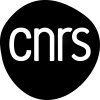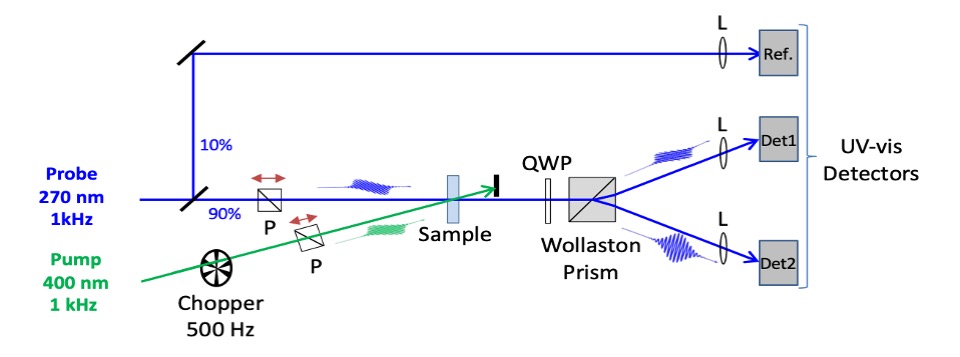Protein and DNA folding dynamics probed by time-resolved circular dichroism
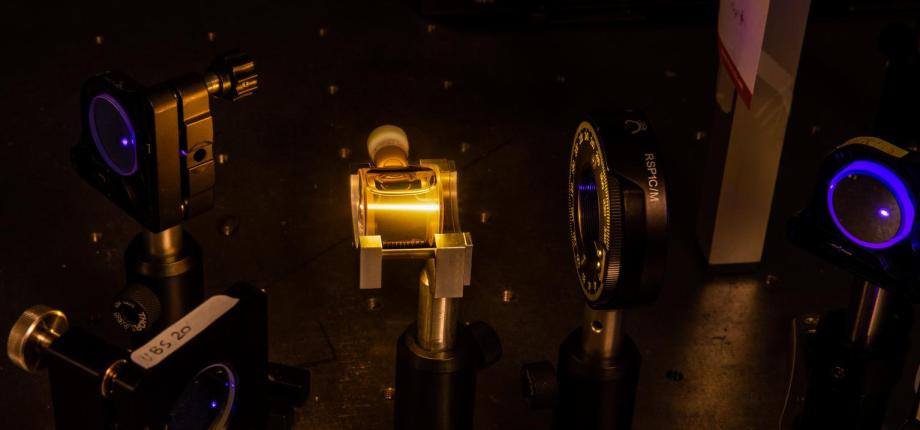
Staff:
Pascale Changenet
Francois Hache
Post-doc:
Vangelis Balanikas
Research topics:
In addition to their three-dimensional structure, the dynamical properties of biomolecules play a key role in their functions. During their folding, they explore a wide range of conformations, which can be difficult to capture experimentally. In this regard, chiroptical methods are powerful tools for probing the structural changes of biomolecules over extended time scales. Among these methods, circular dichroism (CD) is a widely used technique for analyzing the secondary structure of proteins and DNA. However, time-resolved pump-probe CD experiments still present a major technical challenge due to their small signals, which are prone to polarization artifacts induced by the pump.
Our main focus is on the development and use of new user-friendly chiroptical tools to measure the conformational dynamics of proteins and DNA over time scales ranging from femtoseconds to seconds. Part of our research is also devoted to the study of the conformational dynamics of small chiral organic and inorganic molecules in their excited electronic states.
Ongoing Projects:
- Experimental developments
Over the past five years, we have built two complementary monochromatic TRCD setups allowing:
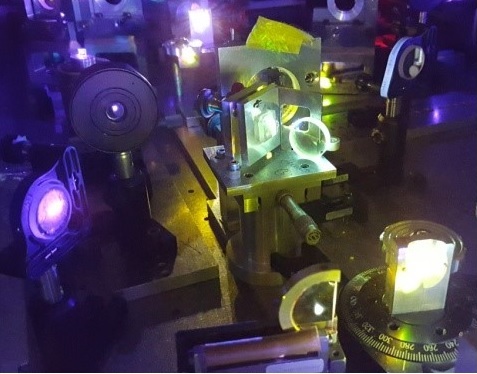 | - To measure the conformational changes of biomolecules following an optical excitation, with a subpicosecond time resolution. - To probe their folding dynamics induced by a temperature jump (T-jump) or photon absorption over a time scale ranging from a few tens of milliseconds to several seconds. |
ANR PRME ChirADASOPS project (2022-2026):
Femtosecond TRCD measurements typically require, for each pump-probe delay, either a modulation on a circularly polarized probe or a variable phase delay on a linearly polarized probe. These sequential acquisition procedures are usually very time-consuming and highly sensitive to pump and probe fluctuations. As part of the ChirADASOPS project, we have developed a "single-shot" TRCD detection method based on the full characterization of the elliptical polarization of the probe transmitted by a chiral sample, using the combination of a broadband quarter-wave plate and a Wollaston prism. This simple and robust method allows us to measure TRCD kinetics with a precision of <1 mdeg, in a few minutes.
Ongoing work aims to combine this new "single-shot" TRCD detection with the ADASOPS method to measure the photoinduced conformational changes of biomolecules over a time scale ranging from a few hundred femtoseconds to milliseconds, by using a pump-probe setup combining a TiSa laser source and a Yb laser source.
Single-shot TRCD | 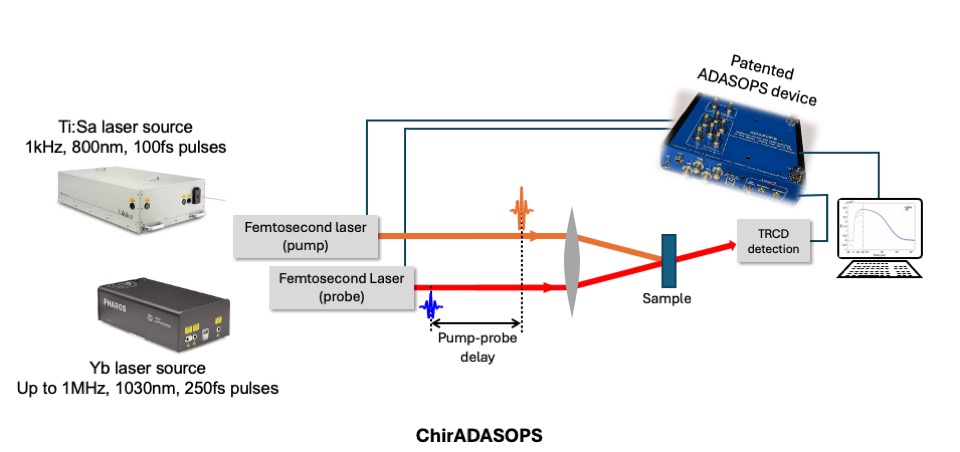 |
- G-quadruplex folding dynamic
 | DNA can adopt a wide variety of conformations. Among them, G-quadruplexes (G4) are structures formed by guanine-rich sequences that result from the stacking of guanine quartets in the presence of metallic cations such as K+ or Na+. G4 are transient DNA structures involved in important cellular regulation functions. However, their folding mechanisms are still poorly understood. |
Our studies aim to characterize the folding dynamics of G4 structures over time scales ranging from picoseconds to seconds, using a combination of transient absorption and TRCD techniques. We have measured the folding kinetics induced by temperature jumps for various G4 sequences. We found that the folding kinetics of parallel G4 structures are significantly slower than those of antiparallel topologies. These initial results suggest the existence of multiple folding pathways along highly complex energy landscapes, strongly influenced by the applied perturbation, loop sequence, and metallic cation concentration. We are currently conducting comparative studies of photo-induced G4 folding dynamics using azobenzene-derived photoswitches synthesized by Bastien Nay (LSO, École Polytechnique).
- Control of chirality in small organic compounds
| The control of chirality at both molecular and macroscopic levels is a major challenge in contemporary chemistry. In this context, axially chiral molecules, such as 1,1′-bi-2-naphthol (binol), have attracted significant interest for several decades. | 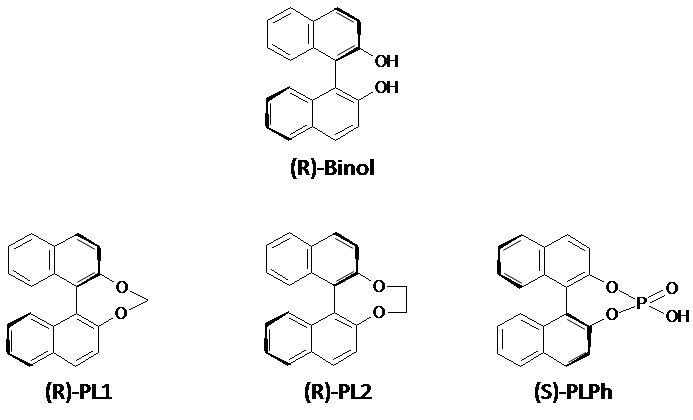 |
Binols are used in a wide range of applications, from molecular recognition to asymmetric catalysis. More recently, their use has extended to the design of functional chiral supramolecular assemblies and innovative organic materials for applications in linear and non-linear optics. The chirality of binols arises from the hindered rotation of their two naphthyl subunits, giving them strong chiroptical activity. While the origin of the chiroptical properties of binols in the ground state is now well understood, their behavior in excited electronic states remains poorly understood.
Thanks to improvements in our sub-picosecond TRCD setup, we have conducted an exhaustive study of three bridged binol derivatives in various solvents. These measurements allowed us to disentangle the respective effects of the solvent and substituents on the chiroptical properties of bridged binol derivatives in their excited state.
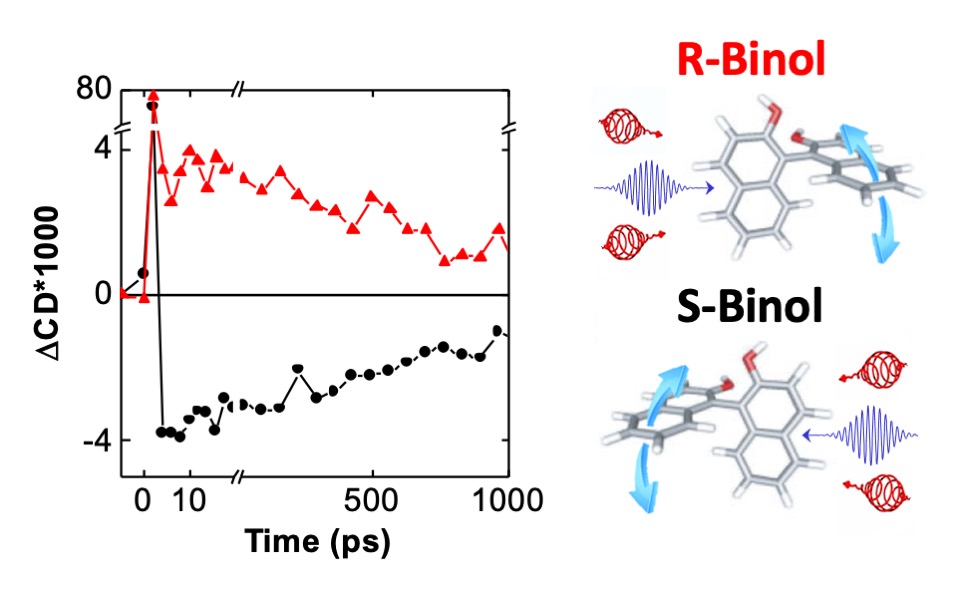 | In particular, we demonstrated that the presence of the bridges does not prevent the rotational motion of their naphthyl subunits in the excited state, leading to a significant increase in their chiroptical response. We are continuing these studies on axial chirality with other binol derivatives. |
Collaborations:
Bastien Nay, LSO, Ecole Polytechnique, Palaiseau.
Giorgio Schirò, Institut de Biologie Structurale, Grenoble, France
Ludovic Favereau, Institut des Sciences Chimiques, Rennes
Roberto Improta, Istituto Biostrutture e Bioimmagini, Consiglio Nazionale delle Ricerche, Napoli, Italy.
Fabrizio Santoro, Consiglio Nazionale delle Ricerche, Istituto di Chimica dei Composti Organometallici, Pisa, Italy.
Stephan Guy, Institut Lumière Matière, Lyon.
Selected publications:
Recent advances in the development of ultrafast electronic circular dichroism for probing the conformational dynamics of biomolecules in solution, P. Changenet and F. Hache, EPJ Special Topics, https://doi.org/s11734-022-00679-3
Artifact-free balanced detection for the measurement of circular dichroism with a sub-picosecond time resolution, P. Changenet and F. Hache, Opt. Expr. https://doi.org/10.1364/OE.489468
Multiscale conformational dynamics probed by Time-resolved circular dichroism from milliseconds to picoseconds, F. Hache and P. Changenet, Chirality , https://doi.org/10.1002/chir.23359
Folding dynamics of DNA G-quadruplexes probed by millisecond T-jump circular dichroism, K. Laouer, M. Schmid, F. Wien, P. Changenet, F. Hache, J. Phys. Chem. B, 125, 8088 (2021)
T-jump and circular dichroism: Folding dynamics in proteins and DNA, P. Changenet, F. Hache, Mol. Cryst. Liq. Cryst. 693, 49 (2019)
Unveiling excited-state chirality of binaphthols by femtosecond circular dichroism and quantum-chemical calculations, M. Schmid, L. Martinez-Fernandez, D. Markovitsi, F. Santoro, F. Hache, R. Improta, P. Changenet, J. Phys. Chem. Lett. 10, 4089 (2019)

